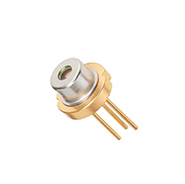Laser Diodes: Technical Support Information
Ushio Laser Diodes: Frequently Asked Questions
What is the difference between a laser diode (LD) and a light-emitting diode (LED)?
Though both LD and LED are semiconductor devices that stimulate the emission of light by injecting current, the light characteristics are quite different. The light emitted from an LED is a random-phase light, which is same as most other lights, but the light emitted from a laser is phase-matched, also known as coherent light, and this suits many unique applications.
Such coherent light can be collimated to a localized spot size and can be sent long distances while keeping this localization. Also, coherent light has interference characteristics that it can apply to disc-reading applications. Furthermore, because LD can be operated at high-speed compared to LED, LD is suitable for applications in which a short pulsed light is required. For example, a light source for the optical reading of an optical disc drive, or light sources for optical communication, etc.)
Are there any necessary precautions when handling laser diodes?
Electrostatic discharge and electrical spikes of the input current should be prevented. These may cause damage to the laser diode. The test equipment and operators body should always be properly grounded.
Which safety standard does Ushio LD comply with?
All Ushio LDs are registered with the FDA of the United States and each LD is classified into class II, IIIa, IIIb, or IV, according to the combination of the optical output power and wavelength values. Please contact Ushio for more details.
What does Ushio's laser line-up consist of? What are their major applications?
Ushio has two types of LD. One is visible LD and other one is infrared LD.
The visible LDs are classified into four types of wavelength band, 400 nm LD, 635 nm LD, 650 to 660 nm LDs, and 670 to 690 nm wavelength band LDs. The 400 nm LDs are suitable for direct imaging application. The 635 nm LDs are suitable for display and levellers used in construction area. The 650 to 660 nm LDs are suitable for the light sources of medical and sensor equipment. The 670 to 690 nm LDs are suitable for the light sources of barcode scanners and various measurement equipment.
The infrared LDs cover wavelengths from 830 to 850 nm, which are invisible to the naked eye. They are suitable for security sensors and various other forms of light source equipment.
Are there any instructions and directions for using LD?
The LD characteristics are changeable by ambient temperature due to its semiconductor components. It is necessary to take account of sufficient heat dissipation within the design, in order to ensure LDs are more stable and reliable during operation.
Which LD characteristics are changeable by the temperature change?
Optical output power changes significantly by temperature change.
An APC (Automatic Power Control) function is recommended for a LD drive circuit to achieve stable operation.
Are there any warnings to use Ushio LDs for medical applications?
It is recommended to contact Ushio directly before using laser products in applications where its failure or malfunction may directly threaten human life or cause risk of bodily injury. This includes situations and industries such as aerospace, aeronautics, nuclear power, combustion control, transportation, traffic, safety equipment or medical equipment for life support.
What is polarisation?
Polarisation is the light which vibrates only directions of certain electrical field and magnetic field. There is no certain polarisation in nature, but LD light is usually linear polarisation.
Generally, polarisation direction means the vibration surface of electrical field. In LD, the vibration of electrical field directed parallel to active layer of LD is called TE (Transverse Electric Wave) mode, as directed to vertical to active layer is called TM (Transverse Magnetic Wave) mode.
How is polarisation presented in Ushio's LDs?
Each LD has TE mode or TM mode (please refer to the next question) and every polarisation direction for its package is different. It is recommended to contact to Ushio sales office when using LDs to the application utilising polarisation.
What is polarisation ratio?
The ratio dividing the 2 surfaces in the LD is limitary because the LD does not have complete linear polarisation.
This is known as the polarisation ratio.
It is different in every LD and has certain level of distribution. It is recommended to contact to Ushio sales office when using LD to the application utilising polarisation.
Is it possible to modulate the LD in pulse condition?
It is possible to modulate Ushio LD in pulse condition within absolute maximum ratings as specified by each LD. (As for LD specified pulse output power, it is usable within absolute maximum power under specified pulse condition.)
Also available, modulated pulse frequency depends on each LD. So it is recommended to ask the Ushio sales team for details when using LD in pulse condition.
Could you inform the equivalent circuit of internal LD?
Circuit constants differ from one LD to another, therefore, it is recommended to contact Ushio directly for more details.
Are Ushio LDs RoHS compliant?
Yes, all Ushio laser diodes are RoHS compliant.
Visit our downloads page for the latest Ushio catalogues.
Visit our contact page to make a product enquiry.


